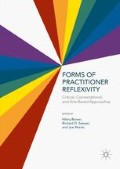Abstract
The use of portfolios is becoming more and more prevalent in university and college programs, especially professional programs such as medicine, nursing, and education (Jones, 2010; McCready, 2007; Ryan, 2011; Woodward & Nanlohy, 2010). Portfolio assessment requires students to demonstrate their competency and learning over time through the use of various artifacts and reflections. As researcher-participants, we employ duoethnography, a relatively new qualitative method (Sawyer & Norris, 2013), to examine our personal experiences with portfolio development and assessment. Using electronic and blended methods of communication, we engage in reflective practice as we examine the professional portfolios that we created in our respective teacher education programs. Throughout this chapter, we demonstrate how engaging in hybrid conversations, conducted primarily online by email, but also in-person, by text messaging or phone, can serve as a worthwhile approach for facilitating professional conversations and promoting continuous professional learning.
Access this chapter
Tax calculation will be finalised at checkout
Purchases are for personal use only
References
Arnett, R. C., Bell, L. M., & Fritz, J. M. H. (2010). Dialogic learning as first principle in communication ethics. Atlantic Journal of Communication, 18, 111–126.
Birden, H. H., & Usherwood, T. (2013). “They liked it if you said you cried”: How medical students perceive the teaching of professionalism. Medical Journal of Australia, 199, 406–409.
Black, P., & Wiliam, D. (2009). Developing the theory of formative assessment. Educational Assessment, Evaluation and Accountability, 21(1), 5–31. doi:10.1007/s11092-0089068-5.
Burch, B. (2004). Dialectic. English Studies in Canada, 30, 16–20.
Davies, A., & Herbst, S. (2013). Assessment in the service of learning. Education Canada, 53(3), 17.
Earl, L. M. (2003). Assessment as learning: Using classroom assessment to maximize student learning. Thousand Oaks, CA: Corwin.
Eva, K., & Regehr, G. (2005). Self-assessment in the health professions: A reformulation and research agenda. Academic Medicine, 80(Suppl), S46–S54.
Eva, K. W., & Hodges, B. D. (2012). Scylla or charybdis? Can we navigate between objectification and judgement in assessment? Medical Education, 46(9), 914–919. doi:10.1111/j.1365-2923.2012.04310.x.
Fernsten, L., & Fernsten, J. (2005). Portfolio assessment and reflection: Enhancing learning through effective practice. Reflective Practice, 6(2), 303–309.
Hetzner, S., Heid, H., & Gruber, H. (2012). Change at work and professional learning: How readiness to change, self-determination and personal initiative affect individual learning through reflection. European Journal of Psychology of Education, 27, 539–555. doi:10.1007/s10212-011-0094-1.
Jones, E. (2010). A professional practice portfolio for quality learning. Higher Education Quarterly, 64(3), 292–312. doi:10.1111/j.1468-2273.2010.00458.x.
Kilgore, D., Sattler, B., & Turns, J. (2013). From fragmentation to continuity: Engineering students making sense of experience through the development of a professional portfolio. Studies in Higher Education, 38(6), 807–826. doi:10.1080/03075079.2011.610501.
Larrivee, B. (2000). Transforming teaching practice: Becoming the critically reflective teacher. Reflective Practice, 1(3), 293–307. doi:10.1080/1462394002002556.
Lester, D., Hvezda, J., Sullivan, S., & Plourde, R. (1983). Maslow’s hierarchy of needs and psychological health. The Journal of General Psychology, 109, 83–85.
McCready, T. (2007). Portfolios and the assessment of competence in nursing: A literature review. International Journal of Nursing Studies, 44, 143–151. doi:10.1016/j.ijnurstu.2006.01.013.
Norris, J., Sawyer, R., & Lund, D. E. (2012). Duoethnography: Dialogic methods for social, health, and educational research. Walnut Creek, CA: Left Coast Press.
Ramaprasad, A. (1983). On the definition of feedback. Behavioral Science, 28, 4–13. doi:10.1002/bs.3830280103.
Ryan, M. (2011). Evaluating portfolio use as a tool for assessment and professional development in graduate nursing education. Journal of Professional Nursing, 27, 84–91. doi:10.1016/j.profnurs.2010.09.008.
Saldana, J. (2009). The coding manual for qualitative researchers. Thousand Oaks, CA: Sage.
Sawyer, R. D., & Norris, J. (2013). Duoethnography: Understanding Qualitative Research. New York: Oxford University Press.
Sebok, S. S. (2014). Understanding the complexities of validity using reflective practice. Reflective Practice: International and Multidisciplinary Perspectives, 15, 445–455. doi:10.1080/14623943.2014.900015.
Wiliam, D. (2011). Embedded formative assessment. Bloomington, IN: Solution Tree.
Woods, J. and Sebok, S. (2013, June). Exploring the potential of duoethnography as a method: Understanding professionalism. Proceedings of the Canadian Society for the Study of Education (CSSE), University of Victoria, Victoria, British Columbia.
Woodward, H., & Nanlohy (2010). Digital portfolios in pre-service teacher education. Assessment in Education: Principles, Policy & Practice, 11(2), 167–178. doi:10.1080/0969594042000259475.
Author information
Authors and Affiliations
Editor information
Editors and Affiliations
Copyright information
© 2016 The Author(s)
About this chapter
Cite this chapter
Woods, J.C., Sebok, S.S. (2016). Promoting Professional Conversations and Reflective Practice Among Educators: Unpacking Our Portfolios Using Duoethnography. In: Brown, H., Sawyer, R., Norris, J. (eds) Forms of Practitioner Reflexivity. Palgrave Macmillan, New York. https://doi.org/10.1057/978-1-137-52712-7_4
Download citation
DOI: https://doi.org/10.1057/978-1-137-52712-7_4
Published:
Publisher Name: Palgrave Macmillan, New York
Print ISBN: 978-1-137-52711-0
Online ISBN: 978-1-137-52712-7
eBook Packages: EducationEducation (R0)

